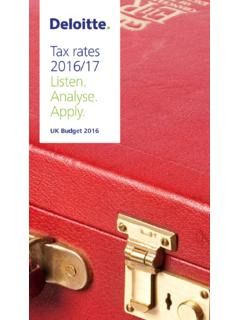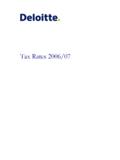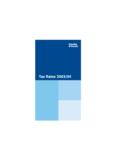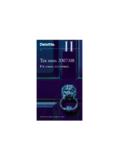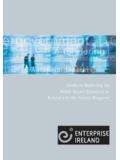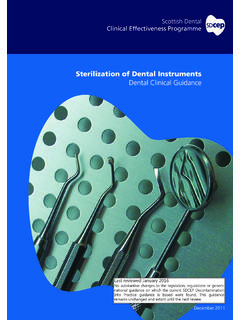Transcription of http://www.ukbudget.com/files/deloitte-uk-tax-rates-2018-19.pdf
1 The budget, in fullTax rates 2018/19 Autumn Budget 2017 ContentsThese tables are a summary and do not cover all situations. They are based primarily upon information in the Budget announcements on 22 November 2017. These may be subject to further changes announced after 22 November 2017 are not generally reflected in these tables, changes to the income tax and stamp taxes sections were incorporated on 13 March 2018 to reflect recent devolved tax developments in Scotland and Wales. This publication has been written in general terms and therefore cannot be relied on to cover specific situations; application of the principles set out will depend upon the particular circumstances involved and we recommend that you obtain professional advice before acting or refraining from acting on any of the contents of this Tax 1 Indirect taxes 12 National Insurance contributions 19 Business tax 22 Offices 27 Income tax rates 2018/19 (2017/18)Personal TaxIncome band ( )Dividends (%)Other savings income (%)Up to 34,500a, b (up to 33,500) 7.
2 52034,500 150,000b (33,500 150,000) 40 Over 150,000b (over 150,000)3 8 .145 Income band ( )Other income (%)Cumulative tax ( )Up to 34,500c (up to 33,500) Basic rate: 206,900 (6,700)34,500 150,000c (33,500 150,000)Higher rate: 405 3 ,10 0 (53,300)Over 150,000c (over 150,000)Additional rate: 45a. A 0% starting rate applies to the first 5,000 of savings income. For many taxpayers this is not relevant as the starting rate does not apply if their taxable non-savings income exceeds the starting rate Subject to Personal Allowance, Personal Savings Allowance, and Dividend Allowance (see page 3).c. Subject to Personal Allowance, Property Allowance, and Trading Allowance (see page 3).The income bands are broadly used in the following order: Non -savings income Savings income DividendsDiscretionary trusts and accumulation and maintenance trusts are entitled to a standard rate band of 1,000. Income in excess of this amount is subject to income tax at the top rate of income tax which is 45%.
3 The rate of tax on dividend income received in excess of the standard rate band is budget, in full | Tax rates 2018/19 Income tax rates ScotlandIncome band ( ) 2018/19 Other income (%)Cumulative tax ( )Up to 2,000 Starter rate: 193802,0 0 0 12,150 Scottish basic rate: 202,41012,150 31,58 0 Intermediate rate: 216,49031,580 150,000 Higher rate: 4155,043 Over 150,000 Top rate: 46 Subject to Personal Allowance, Property Allowance, and Trading Allowance for 2018/19 (see page 3). Income band ( ) 2017/18 Other income (%)Cumulative tax ( )Up to 31,500 Scottish basic rate: 206,30031,500 150,000 Higher rate: 4053,700 Over 150,000 Additional rate: 45 Subject to Personal Allowance, Property Allowance, and Trading Allowance for 2017/18 (see page 3).The Scottish Parliament has the power to set income tax rates and bands for non savings, non-dividend income of Scottish resident taxpayers. The following five tax rates and bands for non-savings income for 2018/19 were passed by the Scottish Parliament on 20 February 2018:In 2017/18, the following three rates and bands applied to the non-savings, non-dividend income of Scottish resident taxpayers: The dividend and other savings tax rates and bands on page 1 apply to the dividend and other savings income of Scottish budget, in full | Tax rates 2018/19 Income tax allowances2018/19 ( )2017/18 ( )Personal Allowance Individuals a, d, e11, 8 5 011, 5 0 0 Married Couple s Allowance (elder aged 83 and over on 6 April 2018) b, c, d8,6958,445 Personal Savings Allowance for basic rate taxpayers f1,0001,000 Personal Savings Allowance for higher rate taxpayers f500500 Dividend Allowance g2,0005,000 Property Allowance h1,0001,000 Trading Allowance h1,0001,000a.
4 Reduced by 1 for each 2 of income (less deductions) in excess of 100, Reduced by 1 for each 2 of income (less deductions) which exceeds 28,900 (2017/18: 28,000). The minimum age-related married couple's allowance is 3,360 (2017/18: 3,260).c. Restricted to relief at 10%.d. None of these allowances are available to non-UK domiciled individuals who makes a claim to pay tax on the remittance basis of Spouses or civil partners will be able to transfer 1,190 (2017/18: 1,150) of their unused Personal Allowance to their partner. This is available provided neither person pays tax at the higher rate. (Legislation is expected in 2018 to clarify the application of this condition to Scottish resident taxpayers.) This is not available if the couple are in receipt of married couple s allowance. f. A 0% tax rate for personal savings income for basic and higher rate taxpayers A 0% tax rate for dividend income available to all Allowances for property income and trading income available to all UK resident taxpayers.
5 Where individuals are in receipt of gross property income or gross trading income below the new allowances, the income will not be subject to income tax. Where gross receipts are in excess of these amounts, the recipient can choose to take the 1,000 allowance as a deduction against their gross income instead of deducting actual expenses to arrive at their taxable income budget, in full | Tax rates 2018/19 Income tax reliefs and incentivesAnnual limits2018/19 ( )Enterprise Investment Scheme (EIS) (maximum) a1,000,000 Seed Enterprise Investment Scheme (SEIS) (maximum) b100,000 Venture Capital Trust (VCT) (maximum) c200,000 Individual Savings Account (ISA) (maximum) d, e20,000 Junior ISA (maximum per child)4,260a. Income tax relief restricted to 30%. Capital gains tax deferral on gains on disposal of other assets is also available. From 6 April 2018, the annual limit is doubled to 2 million, provided any amount over 1 million is invested in one or more knowledge-intensive companies.
6 B. Rate of income tax relief is 50%. The relief applies to shares in qualifying trading companies with fewer than 25 full-time equivalent employees, and assets of up to 200,000 issued after 6 April 2012. Maximum stake 30% of share capital and voting rights. Total SEIS financing per company is limited to 150,000 cumulatively (within three years preceding the share issue).c. Rate of income tax relief for investors in VCTs is 30%. Dividends received on qualifying VCT investments are exempt from income A Help to Buy ISA enables first time buyers saving up to 200 per month plus an initial amount of up to 1,000 towards their first home to receive a government bonus of 25% of the amount saved. The Government will contribute a maximum of 3,000 on 12,000 of savings. e. A Lifetime ISA can be opened by individuals between the ages of 18 and 40. Individuals can save up to 4,000 each tax year into an account which will be topped up at the end of the tax year with a government bonus of 25%.
7 The money saved, including the bonus, can be used to buy a first home worth up to 450,000 or can be withdrawn from the age of 60. Any contribution to this new Lifetime ISA counts towards the overall ISA subscription is available at the taxpayer's marginal rate of income tax for charitable donations via the Gift Aid and Payroll Giving schemes and for charitable gifts of quoted shares and securities and real budget, in full | Tax rates 2018/19 Pensions2018/19 ( )2017/18 ( )Annual allowance40,000 a, b, c40,000 a, b, cMoney purchase annual allowance4,000 c4,000 cLifetime allowance1,030,000 d1,000,000 da. The annual allowance is reduced by 1 for every 2 of income over 150,000, including relievable contributions, to a minimum of 10, The annual allowance may be increased by up to 120,000 with unused relief from the previous three Where a member has flexibly accessed his uncrystallised or drawdown fund, the annual allowance for contributions to a money purchase scheme is capped at the level of the money purchase annual allowance, with no unused allowance brought forward.
8 A potentially higher limit for defined benefit schemes The standard lifetime allowance, which is the total value of pensions savings that can be accumulated without a tax recovery charge when a pension or lump sum is taken, has reduced on a number of occasions in recent years. Various transitional protection rules exist and, subject to conditions, members who have elected into them may continue to benefit from higher tax-free contributions made by employers and employees to a money purchase (defined contribution) registered pension scheme attract an annual allowance charge to the extent they exceed the annual allowance for the tax year in which the pension input period ends, augmented by any brought forward unused relief from the previous three years. No charge arises where the member dies in the year or is medically assessed as unable to work ever annual allowance charge similarly applies to salary-related pension accrual where the inflation-adjusted increase in pension entitlement, multiplied by a valuation factor of 16, exceeds the annual limit.
9 No charge applies where the member s active participation in the scheme has ceased. Where the annual limit is exceeded, tax is payable on the excess at the individual s marginal (ie 20%, 40% or 45%) rate. This is normally payable by the individual via self-assessment, but in some cases they may elect for the pension scheme to pay the tax drawing a pension, the maximum tax-free pension commencement lump sum payable is the lesser of 25% of the value of an individual s uncrystallised fund, 25% of the member s lifetime allowance and one third of the amount crystallised for the payment of a pension or annuity for life, or as funds available for drawdown. 5 The budget, in full | Tax rates 2018/19 Subject to the agreement of the scheme administrator, members of money purchase schemes who have reached the minimum pension age of 55 will be able to take funds from their drawdown account flexibly whenever they want, and in any desired amount. Members will also have the option of taking an uncrystallised funds pension lump sum , 25% of which is tax-free, provided they have sufficient lifetime allowance available.
10 If the member dies before age 75 any unused drawdown or undrawn uncrystallised funds can be paid to dependants free of tax. After that age lump sums are taxable. Death benefit lump sums will normally be taxed as pension income of the recipient (ie marginal income tax rates).In certain circumstances, including when a member takes a pension or lifetime annuity, designates funds for drawdown, dies holding uncrystallised funds or takes a pension commencement or uncrystallised funds pension lump sum, his aggregate pension savings are also tested against the lifetime limit, taking account of any previous benefit crystallisation event. Any excess is taxed at 25%, or 55% if taken as a lifetime allowance excess lump sum. Any unauthorised lump sum is taxed on the member at rates of 40% or 55%, with a further charge on the contributions to pensions is a long term investment decision and individuals should take advice on the suitability of making pension contributions in their particular budget, in full | Tax rates 2018/19 Company car, van and fuel benefitsFor more detail see company car benefit is calculated by multiplying the car's list price (including selected optional accessories) by the relevant percentage graduated according to the car s carbon dioxide (CO2) emissions.
